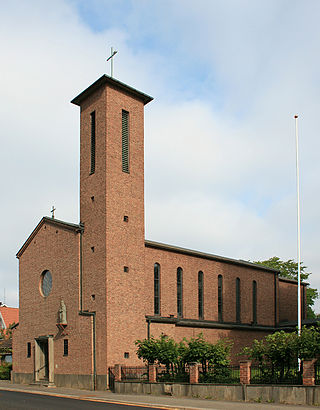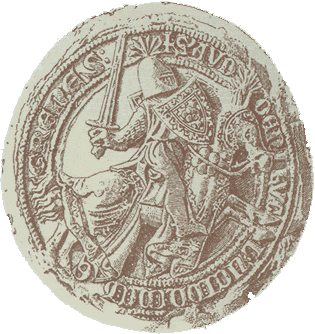
Sigrid Undset was a Danish-born Norwegian novelist. She was awarded the Nobel Prize for Literature in 1928.

Haakon V Magnusson was King of Norway from 1299 until 1319.

Eric Magnusson was the King of Norway from 1280 until 1299.

Akershus Fortress or Akershus Castle is a medieval castle in the Norwegian capital Oslo that was built to protect and provide a royal residence for the city. Since the Middle Ages the fortress has been the namesake and centre of the main fief and later main county of Akershus, which was originally one of Norway's four main regions and which included most of Eastern Norway. The fortress itself was located within the Akershus main county until 1919, and also within the smaller Akershus sub county until 1842.

Inge II was King of Norway from 1204 to 1217. His reign was within the later stages of the period known in Norwegian history as the age of civil wars. Inge was the king of the birkebeiner faction. The conclusion of the settlement of Kvitsøy with the bagler faction in 1208 led to peace for the last nine years of Inge’s reign, at the price of Inge and the birkebeiner recognising bagler rule over Viken.

Birger Magnusson was King of Sweden from 1290 to 1318. His reign was marked by unrest and civil strife; he was imprisoned by his brothers Erik and Valdemar following the "Håtuna games" in 1306, but when he tried to play them the same trick in Nyköping, there was an uprising that ended with Birger losing the crown and the execution of his 18-year-old son Magnus.
The Norwegian Law of Succession was first introduced in 1163 during the Civil war era in Norway.
Tryggve Olafsson was the king of Viken, Norway.
Erling Ormsson, known as Erling Skakke, was a Norwegian Jarl during the 12th century. He was the father of Magnus Erlingsson, who reigned as King of Norway from 1161 to 1184.

Ingeborg of Norway was a Norwegian princess and by marriage a Swedish royal duchess with a position in the regency governments in Norway (1319–1327) and Sweden (1319–1326) during the minority of her son, King Magnus Eriksson. In 1318–1319, she was Sweden's de facto ruler, and from 1319 until 1326, she was Sweden's first de jure female regent. Her role in northern European history is considered of major importance.

The Master of Hestviken is a tetralogy about medieval Norway written by Sigrid Undset. It was originally published in Norwegian as two volumes Olav Audunssøn i Hestviken and Olav Audunssøn og Hans Børn, from 1925 to 1927. Hestviken is a fictional mediaeval farm on the East side of the Oslo fjord. The series is set partly during the Civil war era in Norway, in which period the Bagler faction frequently established themselves in the nearby Viken area. It's inspired by the summer cottages located in Hvitsten, near Drobak. In the 1920s, Sigrid Undset resided there for a brief period.

The Sudreim claim was an entitlement to the throne of the Kingdom of Norway held among members of the powerful and influential House of Sudreim in the late Middle Ages.
Sigurd Erlingsson Ribbung was a Norwegian nobleman and pretender to the throne of Norway during the civil war era in Norway.
Erling Vidkunsson (1293–1355) was the Norwegian nobleman and regent of Norway. He received the position of High Justiciar (drottsete) of the country. He was Lord of Bjarkoy and Giske and was probably the most important and wealthy Norwegian noble of his era.

Thorfinn of Hamar was the Bishop of the Ancient Diocese of Hamar in medieval Norway.
Ingeborg Eriksdotter was Queen of Norway and the wife of King Magnus VI. She was born a Danish princess, daughter of Eric IV of Denmark. As queen dowager, she played an important part in politics during the minority of her son King Eirik II of Norway in 1280-82.

Audun Hugleiksson (Hestakorn) (c. 1240 – 2 December 1302) was a Norwegian nobleman at the end of the 13th century. He was the king's right hand, both under King Magnus Lagabøte and King Eirik Magnusson. He was seen as an important politician and lawman in his time and played a central role in reforming the Norwegian law system.

Erik Valdemarsson the Elder was a Swedish prince and riksråd for Norway and Sweden. He was the son of King Valdemar of Sweden and Queen Sophia of Denmark. He is the progenitor of the Valdemarsgren branch of the House of Bjälbo. He married Ingeborg Knutsdotter (Aspenäsätten).













